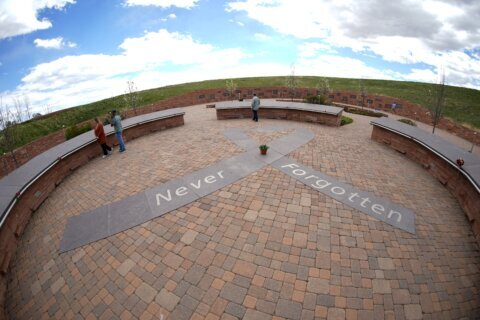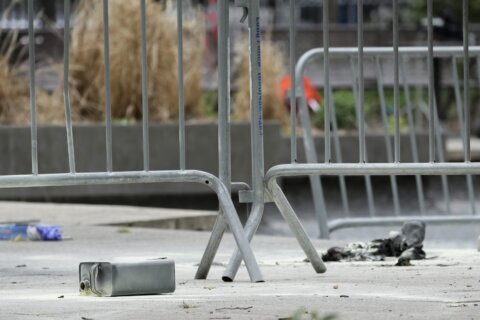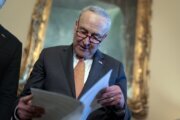A war rages on in America, and it didn’t begin with Donald Trump or the assault on the Capitol.
It started with slavery and never ended, through lynchings and voter suppression, the snarling attack dogs of Bull Connor and the insidious accounting of redlining.
Today’s battles in the race war are waged by legions of white people in the thrall of stereotypes, lies and conspiracy theories that don’t just exist for recluses on some dark corner of the internet.
People like the murderer who fatally shot nine Black parishioners at a church in South Carolina, telling detectives that Black people were taking over the country and raping white women. And the shooter who killed 23 and wounded 23 others at a Walmart in El Paso, Texas — targeting Mexicans, authorities say, because he believed they were invading the country to vote for Democrats.
And the riotous mob, rife with white supremacists, that bought in when Trump and others insisted falsely that the presidential election was stolen, mostly in areas where people of color live and vote.
For a very long time, civil rights leaders, historians and experts on extremism say, many white Americans and elected leaders have failed to acknowledge that this war of white aggression was real.
Racist notions about people of color, immigrants and politicians have been given mainstream media platforms, are represented in statues and symbols to slaveholders and segregationists, and helped demagogues win elections to high office.
The result? A critical mass of white people fears that multiculturalism, progressive politics and the equitable distribution of power spell their obsolescence, erasure and subjugation. And that fear, often exploited by those in power, has proven again and again to be among the most lethal threats to nonwhite Americans, according to racial justice advocates.
So how does the nation begin addressing the war of white aggression after countless missed opportunities?
The Rev. William Barber II said it starts with collectively refusing to have political debates rooted in lies and racist tropes.
“The collateral damage, when you keep unleashing the lies, sow the wind and pour this poison into the veins of people, is the system becomes so septic that violence spews out of it,” the civil rights leader said.
Historically, white supremacy has advanced in lockstep with fears of Black political power. After the Civil War, when formerly enslaved people got the right to vote and hold office, the white response was Jim Crow segregation, voter suppression and oppression through law enforcement.
And the Jan. 6 Capitol riot occurred the same day that Georgia declared the winners of its runoff elections — Democrats Raphael Warnock and Jon Ossoff, the first Black and Jewish candidates the Southern state had ever sent to the U.S. Senate. And it happened as Inauguration Day approached for Kamala Harris, the first Black and South Asian person sworn to serve as vice president.
It should not go unnoted that at least one large Confederate flag was waved by the Capitol trespassers.
To many in that mostly white mob, nonwhite Americans wielded an inconceivable amount of political influence in the last election.
“This kind of mob violence, in reaction to Black, brown and white people coming together and voting to move the nation forward in progressive ways, has always been the backlash,” Barber said.
Oren Segal, vice president of the Anti-Defamation League’s Center on Extremism, said we must stop using benign terms like “culture war” to describe violence that literally kills Americans.
“All somebody had to do was actually look at the dead bodies and the killers to realize that the threat of domestic white supremacist violence has been with us for quite a while,” Segal said.
According to the ADL, roughly 74% of extremists who committed homicides in the U.S. between 2010 and 2019 were right-wing extremists, and a majority of those were white supremacists.
Christian Picciolini, a former far-right extremist who founded the deradicalization group Free Radicals Project, said it has become easy to otherize and ignore supporters of far-right movements and hate groups. It has long been part of a collective denial among white people that a real-world, violent threat exists.
“We have to understand that, if we want to prevent this in the future, we have to examine our history — 400 years of what I would classify as our nation’s potholes,” said Picciolini, who last year released the anti-extremist book “Breaking Hate.”
Malcolm Graham, a former state senator in North Carolina, firmly believes that America’s failure to confront white supremacism cost the life of his older sister, Cynthia Graham-Hurd. She was among the nine killed by Dylann Roof in 2015 during a Bible study meeting at Mother Emanuel African Methodist Episcopal Church in Charleston.
The massacre “was a defining moment,” Graham said. But that moment was wasted when officials and media overemphasized how victims’ families forgave the killer, instead of investigating his path to extremism, he said.
During closing arguments at Roof’s trial, a federal prosecutor said the 22-year-old avowed white supremacist intended to start a war between the races.
His actions instead sparked a national reckoning over white supremacist iconography, including the Confederate battle flag, monuments and statues that appeared in photographs and drawings investigators found among Roof’s belongings. In July 2015, former Republican Gov. Nikki Haley, who is Indian American, signed legislation permanently lowering the Confederate battle flag that flew over South Carolina’s Capitol.
There have been moments when it seemed like a reckoning with racism was at hand. After last year’s police killing of George Floyd in Minneapolis, 111 Confederate monuments and other white supremacist symbols were removed, relocated or renamed, the SPLC said. But nearly 1,800 Confederate symbols, including 725 monuments, remained on public land as of December.
“Confederate symbols are not relics of the past — they are living symbols of white supremacy,” SPLC chief of staff Lecia Brooks said.
For Graham, who lost his sister at Mother Emanuel, the onus isn’t on Black people to begin negotiating a truce in the race war. Accountability must come first, he said.
“I think white folks need to have a town hall meeting, and I think they need to start calling their people out,” Graham said. “They have to be able to point a finger at folks that look like them, and point them out at their dinner table, at their churches, at their places of employment.”
_____
Aaron Morrison covers race and justice for The Associated Press as a member of the AP’s Race and Ethnicity team. Follow him on Twitter: https://www.twitter.com/aaronlmorrison.
Copyright © 2024 The Associated Press. All rights reserved. This material may not be published, broadcast, written or redistributed.







